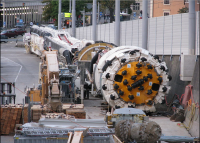








John ""Iron-Mad"" Wilkinson (1728–1808) was an English industrialist who pioneered the use and manufacture of cast iron and cast-iron goods in the Industrial Revolution. He was the inventor of a precision boring machine that could bore cast iron cylinders such as those used in steam engines, which bored for James Watt's engines. His boring machine has been called the first machine tool. He also developed a blowing device for blast furnaces that allowed higher furnace temperatures, increasing their capacity.
James Watt had tried unsuccessfully for several years to obtain accurately bored cylinders for his steam engines, and was forced to used hammered iron, which was out of round and caused leakage past the piston. In 1774 John Wilkinson invented a boring machine in which the shaft that held the cutting tool extended through the cylinder and was supported on both ends, unlike the cantilevered borers then in use. With this machine he was able to bore the cylinder for Boulton & Watt's first commercial engine, and was given an exclusive contract for the provision of cylinders.Until this era, advancements in drilling and boring practice had lain only within the application field of gun barrels for firearms and cannon; Wilkinson's achievement was a milestone in the gradual development of boring technology, as its fields of application broadened into engines, pumps, and other industrial uses.
While the main market for steam engines had been for pumping water out of mines, he saw much more use for them in the driving of machinery in ironworks such as blowing engines, forge hammers and rolling mills, the first rotary engine being installed at Bradley in 1783. Among his many inventions was a reversing rolling mill with two steam cylinders that made the process much more economical.
John Wilkinson took a key interest in obtaining orders for these more efficient steam engines and other uses for cast iron from the owners of Cornish copper mines. As part of this interest he bought shares in eight of the mines to help provide capital.